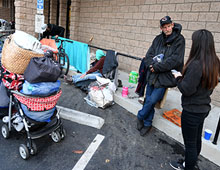Mayor’s Monthly Message July 2021 A Systematic Approach to Homelessness
Published: 06/30/2021
Mayor’s Monthly Message July 2021 A Systematic Approach to Homelessness
Homelessness in our city is a top issue for Riversiders. In a 2019 City Quality of Life survey, nearly 70% of Riversiders indicated that our approach was insufficient to resolve this crisis. I have since proposed a three-pronged strategy to establish more quality housing, fight for our fair share of resources and work regionally with our neighboring communities to make progress. I now provide an update on the latest efforts to address mental and behavioral health needs, the Santa Ana River Bottom, and state budget allocations as part of our continued work to solve homelessness in Riverside.
Approximately 25% of our homeless population suffers from mental and behavioral health challenges, with up to 45% experiencing mental illness. Knowing this data, the City Council and I recently authored a letter advocating that the County of Riverside opt-in to a court-ordered assisted outpatient treatment program known as “Laura’s Law.”
Our submittal to the County Board of Supervisors outlined the treatment program Laura’s Law provides for individuals who are: over 18 years of age suffering from mental illness, have a clinical determination that an individual is unsafe in a community without supervision, and have a history of non-compliance with treatment of mental illness.
The implementation of Laura’s Law can have profound impacts. Supervisor Chuck Washington recently cited a study from May 2018 - April 2019 showing that in the 13 counties that implemented Laura’s Law, homelessness decreased 30%, contact with law enforcement decreased 43%, and violent behavior decreased 64%.
As of May 25, 2021, the County Board of Supervisors unanimously voted to opt-in to Laura’s Law. This is a significant step forward for those needing mental health assistance. We now have county-wide policies that align with what we advocate for in the Mayor’s Office—this is regional coordination that we have not yet had.
While we have made progress on important policy initiatives, there is still more to do in addressing homelessness. Regionally, one of our greatest challenges is the Santa Ana River Bottom.
Last December, Supervisor Karen Spiegel convened the District 2 Homeless Solutions Collaborative focused on the River Bottom. Since then, my team and I have worked with Supervisor Spiegel and others to establish four goals: rehouse existing encampment residents, remove and mitigate physical encampments, conduct clean-up and habitat restoration, and establish effective tools to prevent the recurrence of encampments. We expect to see results of this regional collaboration as early as fall of 2021.
Recent state investments, from interim housing to rental support, have provided cost-effective solutions to end homelessness. A regional approach requires funding to local municipalities, but these targeted programs face continued financial restraints. To fill the gap, the state legislature proposed a $10.6 billion homeless package to be spent over 4 years. Four billion of this will be direct aid to local cities and counties with robust oversight and accountability requirements. On April 29th, I joined my fellow Big City Mayors to advocate for this funding at a virtual press conference. On June 30th, the Governor and state legislature came to agreement on a two-year, annual $1 billion direct allocation to cities for these critical needs. Although less than our initial ask, I commend state leaders for still making the boldest financial commitment to address homelessness in our state’s history.
Addressing homelessness is not an impossible task, but it is also not as simple as people may believe. Progress will not be easy and besides government intervention, it will require committed work by all of us.


